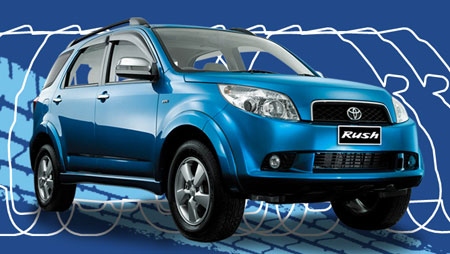

The new Rush is a 7-seater monocoque SUV based on an adapted Toyota Avanza platform, and is powered by a 1.5 liter VVT-i engine called the 3SZ-VE, installed longtitudinally in the Rush’s engine bay. It drives the two rear wheels. The 3SZ-VE produces 109 PS at 6,000rpm and 141Nm of torque at 4,400rpm.
Three variants of the new Toyota Rush are available – the manual 1.5G, the automatic 1.5G and the automatic top of the line 1.5S, which is only available in automatic. The manual variant has the 3SZ-VE paired with a 5-speed manual, while the automatic version has a 4-speed auto with a gated shift. The drivetrain is 2WD, which is lighter and offers better fuel economy.
The Toyota Rush is 4,410mm long, 1,695mm wide and 1,745mm tall including the roof rails. Its wheelbase is 2,685mm long. Track is 1,445mm at the front and 1,460mm at the rear. The manual variant weighs 1,210kg while the automatic is 10kg heavier. The suspension is a MacPherson strut setup with stabilizer bar at the front, and a 4-link live axle at the rear, fitted iwth a lateral rod to maintain axle stability during fast cornering. Front brakes are solid discs while the rear brakes use drums. Turning radius is 5.2 meters, which is better than average for a SUV of this wheelbase. The Toyota Rush has an approach angle of 38.5 degrees and a departure angle of 24.5 degrees.
The Toyota Rush has an interior done up in beige with fabric seats. Cabin length is 2,440mm and cabin width is 1,385mm. There are 3 rows of seats in a 2-3-2 arrangment, and the second row has a 60mm fore-aft slid adjustment with a backrest reclining function. The Rush has second row air conditioning vents mounted on the ceiling, which also serves to cool the third row. The third row takes up most of the car’s boot space, but if you require this boot space you can fold it forwards against the back of the second row. Access to the third row is easy via the double-action folding second row seats, but the low-ish ceiling because of the high-ish floor will make it hard for people with back problems to get into the third row, so be sure to let granny sit in either the front or second row! Access to the boot space is via a side-hinged door which also has the spare tyre mounted on it.
On to equipment levels – the in-car entertainment is a single disc MP3-capable head unit that sends tunes to 6 speakers (4 speakers plus 2 tweeters). The emergency kit includes a jumper cable, first aid kit and a safety triangle. The boot comes with a luggage net. The wing mirrors have turn indicators integrated into them. The Toyota Rush rides on 16 inch alloy wheels wrapped with 215/65R16 tyres. The driver’s seat has height adjustment.
Storage areas are also aplenty – a glovebox, a little coin box, front center storage below the air conditioning controls for your mobile phone and etc, the center console box inside the arm rest, a sunglasses holder, door trim pockets on all doors, seat back pockets, and also third row storage on each side of the car.
The 1.5S has a few extra equipment options over the 1.5G – these include a 2-DIN head unit that also supports cassette other than a CD instead of a 1-DIN unit, projector headlamps instead of reflector lense headlamps, foglamps, an LED-powered high mount stop lamp instead of a bulb-powered one, a rear spoiler, power retractable door mirrors, leather wrapping on the gear shift and steering wheel, dual SRS front airbags (1.5G only has a driver airbag) and strangely – anti-lock brakes and electronic brakeforce distribution. Yup, ABS and EBD are not standard on the Toyota Rush as the 1.5G manual and auto models do not have these safety options.
Warranty for the new Toyota Rush is for 3 years or 100,000km, and the Rush is a CBU import from Indonesia. The following is the price list for Peninsular Malaysia, OTR with insurance:
No comments:
Post a Comment